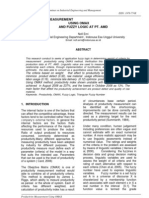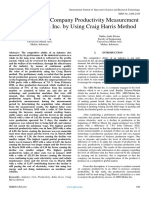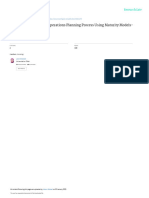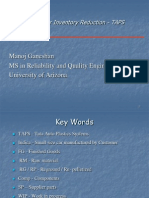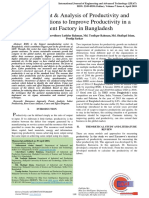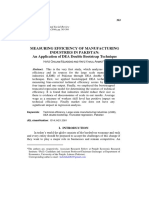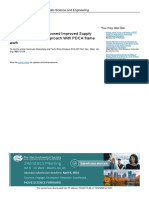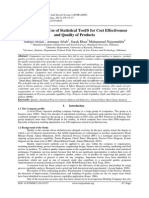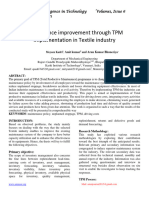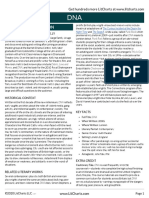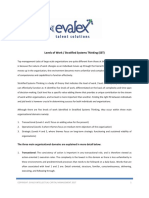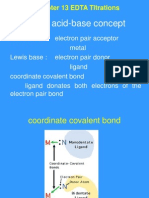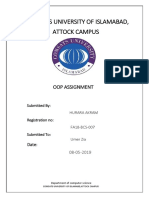Professional Documents
Culture Documents
Productivity Analysis Using Objective Matrix (OMAX) and Five Whys Analysis Methods On Rubber Powder Production Line at PT Tiga Bintang Gautama
Original Title
Copyright
Available Formats
Share this document
Did you find this document useful?
Is this content inappropriate?
Report this DocumentCopyright:
Available Formats
Productivity Analysis Using Objective Matrix (OMAX) and Five Whys Analysis Methods On Rubber Powder Production Line at PT Tiga Bintang Gautama
Copyright:
Available Formats
Volume 6, Issue 8, August – 2021 International Journal of Innovative Science and Research Technology
ISSN No:-2456-2165
Productivity Analysis Using Objective Matrix
(OMAX) and Five Whys Analysis Methods on
Rubber Powder Production Line at Pt Tiga
Bintang Gautama
Jonathan Budhiawan, Erry Rimawan, Jimmy Greei Ganap, Evi Mayasari
Mercu Buana University
Abstract:- Productivity is an essential element in 88% (ratio 1 and 2) and 75% (ratio 5). The five why
achieving good production competitiveness. Companies analysis of the three ratios shows four root causes of the
need to know where their productivity levels are. low productivity score of ratio 1, ratio 2, and ratio 5.
Productivity measurement is instrumental at the After further research with the 5W+1H method, it was
management level in doing strategic planning. Objective found that recommendations for improvement that can
Matrix (OMAX) is a partial productivity measurement be done are to increase the supervisory function in
system used to monitor Productivity in each part of the production, updating SOPs, conducting job evaluations
company with productivity criteria according to the and training, as well as scheduling machine
existence of that part (Objective). The measurement of maintenance.
Productivity using the OMAX method also involves the
AHP method in determining the weight of each ratio. Keywords:- Objective Matrix, OMAX, Analytic Hierarchy
Based on the calculation of Productivity in the period Process, Traffic Light System, Why why Analysis, 5W + 1H
January - August 2020 using the Objective Matrix
Method, the results obtained that the productivity values I. INTRODUCTION
below the average productivity values are the period in
March (-15%), April (-39%), May (-1%) and July (- Research at PT Tiga Bintang Gautama was conducted
65%) 2020. Then from the results of calculations with because of indications of a decline in competitiveness in its
OMAX for the period January-August 2020, the production capabilities. During the observation process, it
achievement scores of each ratio were analyzed using the was found that there were issues related to inadequate
TLS method and calculated the index of achievement Productivity. According to data from PT Tiga Bintang
scores against standard productivity scores. The Gautama's monthly production data during the January -
calculation results show that three ratios get a score August 2020 period, it was found that the ongoing
below the standard. Ratio 1, Ratio 2, and Ratio 5 get an production process could not keep up with the demand for
index of achievement score against the standard score of orders and targets given by the company.
Table 1 Monthly Production Data of PT Tiga Bintang Gautama for the period January – August 2020 (in kg)
January February March April May June July August Average
Purchase Order 15800 16100 16500 14600 15900 15300 15700 15900 15725
Production Targets* 16830 17380 17710 18150 16060 17490 16830 17270 17215
Actual Production 13040 13240 12700 12540 12480 12900 12240 11990 12641.3
The data above shows that during the period January - Why Analysis method. Which will also be followed up with
August 2020, the Production line of PT Tiga Bintang an analysis of problem fixes using the 5W + 1H method.
Gautama could not achieve the production target for each
period. This condition makes the competitiveness of PT II. LITERATURE REVIEW
Tiga Bintang Gautama very low. Calculation of Productivity
is one of the efforts to evaluate the performance of the Understanding Productivity according to Daryanto
production line. The Objective Matrix method is used as a (2012:41), Productivity is a concept that describes the
calculation method because the object studied is only in the relationship between results and sources to produce these
production section. The AHP method is also used as a tool results. Objective Matrix (OMAX) is a partial productivity
to determine the weight of each ratio. And then be further measurement system used to observe Productivity in each
analyzed to determine the cause of the problem with the 5 part of the company with criteria or productivity ratios
following the existence of that part (Objective). This method
IJISRT21AUG817 www.ijisrt.com 1216
Volume 6, Issue 8, August – 2021 International Journal of Innovative Science and Research Technology
ISSN No:-2456-2165
was developed by James L. Riggs, PE., a professor of the below the standard will be analyzed further. From the root
Department of Industrial Engineering at Oregon State cause analysis results using the Five Whys Analysis method,
University in the 1980s in the United States. further analysis will be carried out to obtain
recommendations for improvement using the 5W+1H
In making the OMAX table, a weighting technique method.
with a reliable method is needed. Wherein in this research,
the AHP method is used in weighting the ratio. AHP
(Analytic Hierarchy Process) is a method of measurement
used to find the ratio scale, both from discrete and
continuous pairwise comparisons. Furthermore, to analyze
the OMAX table, the TLS method is also used. The Traffic
Light System or TLS method is used to facilitate researchers
in understanding the achievement of company performance
with the help of 3 color categories, namely red, yellow, and
green.
After that, the root causes of the problem are analyzed
on the ratios that have values below the standard using the
Five Whys Analysis method. This method was first
introduced and developed by Sakichi Toyoda, and Toyota
Motor Corporation of Japan used it to build its
Manufacturing Methodology.
III. RESEARCH METHOD
In this study, there are several stages carried out. The
first stage is to determine the problem by looking at the
phenomena that occur in the research object, then
identifying the problem and collecting the data needed for
research. In this study, primary data (the results of
interviews, FGD, and observations) and secondary data
(production data for Jan-Aug 2020) were used. From the
data that has been collected, the criteria for calculating the
productivity value are determined using the Objective
matrix method. The next step is to calculate the ratio value
for each period. Then each ratio will also calculate the
average and lowest values as a reference in making Figure 1 Research Framework
calculations in the OMAX table. Objective Matrix standard
table creation begins by determining the standard weight of IV. RESULTS AND DISCUSSION
each ratio (score 3), namely the average of the values of
each ratio in the Jan-Aug 2020 period and the lowest value Criteria determination stage
of each ratio as a value on a score of 0 in the OMAX
standard table. Then the company determines the a) Efficiency Criteria
productivity target (score 10) as the target of the Actual Product Quantity (kg)
productivity achievement of each ratio. The next step is to Ratio 1 : Total Working Time (Hours)
calculate the interval scale from 0-3 to fill in the score value
columns 1 and 2 and calculate the interval scale from 3-10 Actual Product Quantity (kg)
Ratio 2 :
to fill in the score value column 4 to 9. Then fill in the Total Manpower (People)
weighting column by calculating the weight of each ratio
Actual Product Quantity (kg)
using the AHP method. Ratio 3 : Raw Materials Used (kg)
After the results of the OMAX standard table Actual Product Quantity (kg)
calculation are complete, the value of each period is entered Ratio 4 : Electrical energy (kWH)
one by one to find the total productivity score for each
period. After that, a performance index is obtained for each b) Effectiveness Criteria
period which shows a surplus or minus from the standard
performance value. The next stage is to analyze further the Actual Product Quantity (kg)
Ratio 5 :
ratios that have the most impact on the low value of total Production Target (kg)
Productivity. The TLS method is used by making a score
Defect Product (kg)
table for each ratio throughout the period studied. Ratios that Ratio 6 :
Actual Product Quantity (kg)
fall into the red zone throughout the period and have a score
IJISRT21AUG817 www.ijisrt.com 1217
Volume 6, Issue 8, August – 2021 International Journal of Innovative Science and Research Technology
ISSN No:-2456-2165
c) Inferential Criteria Ratio Calculation Stage
After determining the criteria and ratios, then a ratio
Number of Absent Workers (people) calculation is made as shown in the table below:
Ratio 7 : Total Manpower (people)
Table 2 Ratio Calculation
Efficiency Effectiveness Inferential
2020 period Ratio 1 Ratio 2 Ratio 3 Ratio 4 Ratio 5 Ratio 6 Ratio 7
(PA/JWK) (PA/JTK) (PA/BB) (PA/EL) (PA/TP) (PC/PA) (TKA/JTK)
January 4.075 32,600 0.952 3.024 0.775 0.051 0.000
February 4.138 33,100 0.956 2,945 0.762 0.046 0.000
March 3.835 30,529 0.958 2.853 0.717 0.043 0.005
April 4.082 32.656 0.950 2.897 0.691 0.053 0.000
May 4.483 35.455 0.949 2,910 0.777 0.054 0.011
June 4.031 32,250 0.956 2,934 0.738 0.047 0.000
July 3,714 29,423 0.949 2,947 0.727 0.054 0.010
August 4.282 34,063 0.959 2,926 0.694 0.043 0.006
average 4080 32,509 0.954 2,929 0.735 0.049 0.004
Lowest 3,714 29,423 0.949 2.853 0.691 0.043 0.000
Highest 4.483 35.455 0.959 3.024 0.777 0.054 0.011
OMAX standard table creation
Then set the final target (Score 10). The final target to be achieved is based on the policies and capabilities of the company.
Table 3 Target productivity value for each ratio
Ratio 1 Ratio 2 Ratio 3 Ratio 4 Ratio 5 Ratio 6 Ratio 7
(PA/JWK) (PA/JTK) (PA/BB) (PA/EL) (PA/TP) (PC/PA) (TKA/JTK)
Target 5.136 41,084 0.962 3.046 0.955 0.040 0.000
After that, calculate the interval scale to fill in scores 1 and 2 Skor 10 − Skor 4
Interval Scale : 7
with the following formula.
Skor 3 − Skor 0 n score : Score n-1 + Interval Scale
Interval Scale :
3
After that, determine the weight of each ratio in the
n score : Score n-1 + Interval Scale OMAX matrix. In determining the weight of each ratio, the
emphasis is on determining the priority value of the criteria,
Then calculate the interval scale to fill in a score of 4 to 9 namely comparing which one is more important between
with the following formula. one criterion and another. The AHP method was used with
the following results.
IJISRT21AUG817 www.ijisrt.com 1218
Volume 6, Issue 8, August – 2021 International Journal of Innovative Science and Research Technology
ISSN No:-2456-2165
Table 4 The results of the weighting with the AHP method
Ratio 1 Ratio 2 Ratio 3 Ratio 4 Ratio 5 Ratio 6 Ratio 7
Weight
(PA/JWK) (PA/JTK) (PA/BB) (PA/EL) (PA/TP) (PC/PA) (TKA/JTK)
Ratio 1 (PA/JWK) 0.201 0.201 0.296 0.226 0.137 0.082 0.171 19%
Ratio 2 (PA/JTK) 0.201 0.201 0.296 0.226 0.137 0.082 0.171 19%
Ratio 3 (PA/BB) 0.067 0.067 0.099 0.338 0.137 0.082 0.171 14%
Ratio 4 (PA/EL) 0.100 0.100 0.099 0.113 0.410 0.245 0.122 17%
Ratio 5 (PA/TP) 0.201 0.201 0.099 0.038 0.137 0.408 0.220 19%
Ratio 6 (PC/PA) 0.201 0.201 0.099 0.038 0.027 0.082 0.122 11%
Ratio 7 (TKA/JTK) 0.029 0.029 0.014 0.023 0.015 0.020 0.024 2%
After getting the results of the weight of each ratio, then entered into the OMAX standard table.
Table 5 OMAX standard table
Efficiency Effectiveness inferential
Criteria
Ratio 1 Ratio 2 Ratio 3 Ratio 4 Ratio 5 Ratio 6 Ratio 7
(PA/JWK) (PA/JTK) (PA/BB) (PA/EL) (PA/TP) (PC/PA) (TKA/JTK)
Performance
Target 10 5.136 41,084 0.962 3.046 0.955 0.040 0.0000
9 4.985 39,859 0.960 3.030 0.923 0.041 0.0006
8 4,834 38,634 0.959 3.013 0.892 0.042 0.0011
7 4.683 37,409 0.958 2,996 0.861 0.044 0.0017
6 4,532 36,184 0.957 2,980 0.829 0.045 0.0022
5 4.381 34,959 0.956 2,963 0.798 0.046 0.0028
4 4.231 33,734 0.955 2,946 0.766 0.047 0.0034
Standard 3 4080 32,509 0.954 2,929 0.735 0.049 0.0039
2 3.958 31,481 0.952 2,904 0.720 0.050 0.0063
1 3.836 30,452 0.950 2.879 0.706 0.052 0.0086
0 3,714 29,423 0.949 2.853 0.691 0.054 0.0110
Score
Weight % 19 19 14 17 19 11 2
Mark
Performance indicators
Calculating Performance Value and Productivity Index
The results of the calculation of the ratio value in each period are entered into the OMAX standard table to find out the
achievement of the score for each ratio. The following is an example of calculating the ratio score for the January 2020 period.
IJISRT21AUG817 www.ijisrt.com 1219
Volume 6, Issue 8, August – 2021 International Journal of Innovative Science and Research Technology
ISSN No:-2456-2165
Table 6 OMAX table for January 2020 period
Efficiency Effectiveness inferential
Criteria Ratio 1 Ratio 2 Ratio 3 Ratio 4 Ratio 5 Ratio 6 Ratio 7
(PA/JWK) (PA/JTK) (PA/BB) (PA/EL) (PA/TP) (PC/PA) (TKA/JTK)
Performance 4.08 32.60 0.952 3.02 0.77 0.051 0.0000
Target 10 5.14 41.08 0.962 3.05 0.95 0.040 0.0000
9 4.98 39.86 0.960 3.03 0.92 0.041 0.0006
8 4.83 38.63 0.959 3.01 0.89 0.042 0.0011
7 4.68 37.41 0.958 3.00 0.86 0.044 0.0017
6 4.53 36.18 0.957 2.98 0.83 0.045 0.0022
5 4.38 34.96 0.956 2.96 0.80 0.046 0.0028
4 4.23 33.73 0.955 2.95 0.77 0.047 0.0034
Standard 3 4.08 32.51 0.954 2.93 0.74 0.049 0.0039
2 3.96 31.48 0.952 2.90 0.72 0.050 0.0063
1 3.84 30.45 0.950 2.88 0.71 0.052 0.0086
0 3.71 29.42 0.949 2.85 0.69 0.054 0.0110
Score 3 3 2 8 4 1 10
Weight % 19 19 14 17 19 11 2
Mark 57 57 28 136 76 11 20
Performance indicators 385
Based on the results of the productivity calculation using the Objective Matrix method, the productivity value for the
January-Aug 2020 period is obtained. Then the productivity index is calculated by comparing the performance indicators for each
period with the basic period.
Table 7 Productivity index
2020 period Performance indicators Basic period Productivity index
January 385 300 28%
February 367 300 22%
March 255 300 -15%
April 182 300 -39%
May 297 300 -1%
June 318 300 6%
July 106 300 -65%
August 396 300 32%
The table above shows that from the calculations using the OMAX method, there was a decrease in below-standard
Productivity in March, April, May, and July 2020. A negative value indicates it in the productivity index.
Determining Low-Performance Ratio
The calculation of the OMAX method provides data visualization about the Productivity of each period. But in addition to
being able to find out the cause of the decline in productivity, it is necessary to analyze the achievement of scores on each ratio in
the January - August 2020 period. And to simplify the analysis, the Traffic Light System method is also used, which gives
different colors according to the pre-determined TLS range. The following are the results of the analysis of the achievement of
each ratio score.
IJISRT21AUG817 www.ijisrt.com 1220
Volume 6, Issue 8, August – 2021 International Journal of Innovative Science and Research Technology
ISSN No:-2456-2165
Table 8 Traffic Light System
Efficiency Effectiveness inferential
2020 period Ratio 1 Ratio 2 Ratio 3 Ratio 4 Ratio 5 Ratio 6 Ratio 7
(PA/JWK) (PA/JTK) (PA/BB) (PA/EL) (PA/TP) (PC/PA) (TKA/JTK)
January 3 3 2 8 4 1 10
February 3 3 5 3 3 5 10
March 1 1 7 0 2 7 2
April 3 3 1 2 0 0 10
May 5 5 0 1 4 0 7
June 2 2 5 3 3 4 10
July 0 0 0 4 2 0 0
August 4 4 8 3 0 7 2
Total 21 21 28 24 18 24 51
Weight % 19 19 14 17 19 11 2
Total Score 399 399 392 408 342 264 102
basic score 456 456 336 408 456 264 48
Percentage
88% 88% 117% 100% 75% 100% 213%
achievement
With the help of the TLS method in the table above, it three ratios have below standard achievements. Thus, these
is easy to identify the ratios that require immediate three ratios will be analyzed for causes and
improvement. Among them are ratio 1, ratio 2, and ratio 5, recommendations for improvement.
where the three ratios have no scores in the green zone.
Root Cause Analysis (Five Whys Analysis)
The percentage of achievement of the total score of Of the three ratios that have scores below the standard,
each ratio to the basic score of each ratio also shows that the root cause analysis uses the 5 Whys Analysis method.
Table 9 5 Whys Analysis
Items Why 1 Why 2 Why 3 Why 4 Why 5 Root Cause
The Production The Production
Supervisor does Supervisor does
The efficiency of A lot of time is not carry out the not carry out the
Working Hours to Inefficient use Inefficient way of wasted on supervisory supervisory
Ratio 1
Total Actual of working time working unnecessary function in a function in a
Production is low activities strict and strict and
disciplined disciplined
manner. manner.
The efficiency of
There is no There is no
the Number of Cooperation in Lack of workers
SOP is not going written SOP that written SOP that
Ratio 2 Labor against the work is not understanding of
well is clear and easy is clear and easy
amount of Actual efficient efficient work
to understand to understand
Production is low
No job
Unproductive No job evaluation
evaluation and
workers and training
Actual Production training
Low Actual
Effectiveness The machine
Ratio 5 Production
against Low cannot reach the Maintenance Maintenance
Achievement
Production Target required machine not machine not
production noticed noticed
capacity
Improvement Recommendation (5W+1H)
IJISRT21AUG817 www.ijisrt.com 1221
Volume 6, Issue 8, August – 2021 International Journal of Innovative Science and Research Technology
ISSN No:-2456-2165
After analyzing the root cause of the low productivity value of ratio 1, ratio 2, and ratio 5. It was found that there were four
root causes of the problem. From the four root cause points, an analysis of the repair of the problem was carried out using the 5W
+ 1H method. The following table is an analysis of improvements using the 5W + 1H method.
Table 10 5W+1H
Items Root Cause What Why Where when Who How
The
The Production
Production
Supervisor
Supervisor The production
does not carry Carry out the
does not supervisor does not
out the supervisory function
Ratio carry out the understand his Dep. 2021 Spv
supervisory properly so that
1 supervisory obligations in carrying Production period production
function in a production continues
role in a out the supervisory
strict and to run optimally.
tough and function.
disciplined
disciplined
manner.
manner.
SOP has never been
It updates the SOP
There is no There is no updated in the last few
with a language that is
written SOP written SOP years and has not
Ratio Dep. 2021 Kep easier to understand
that is clearly that is clearly made posters or
2 Production period Production and makes a printed
and easily and easily pamphlets that the
version to be pasted in
understood. understood. operator can read at
the production area.
any time.
They are conducting
job evaluations and
There is no Workers are only training on effective
There is no job Head of
job trained during their Dep. 2021 and efficient work
evaluation and the
evaluation training period, which Production period methods and
training. production
and training. is the first month. providing Industrial
Ratio K3.
5
Because not realizing Perform the most
The Machine that downtime and effective and efficient
Head of
maintenance maintenance decreased machine Dep. 2021 maintenance
the
engine is not is not performance make a Production period scheduling on the
production
noticed. considered. significant impact on current production
Productivity. scheme.
V. CONCLUSION AND SUGGESTION the 5 Whys Analysis method. The root cause of the
three ratios is obtained as follows.
Conclusion a. Ratio 1 - The Production Supervisor does not carry out
Based on the calculations and analysis of production the supervisory function strictly and is disciplined.
line productivity at PT Tiga Bintang Gautama in this study, b. Ratio 2 - There is no written SOP that is clearly and
the following conclusions were obtained. easily understood.
1. Based on the calculation of Productivity in the period c. Ratio 5 - No job evaluation and training.
January - August 2020 using the Objective Matrix d. Ratio 5 - Machine maintenance is not noticed.
Method, the results obtained that productivity values
below the average productivity values are the periods in And from the four root causes, The improvement
March (-15%), April (-39%), May (-1%) and July (-65 recommendation analysis was carried out using the 5W +
%) 2020. 1H method with the following recommendations for
2. From the results of calculations with OMAX for the
improvement.
period January-August 2020, the achievement of scores
for each ratio using the TLS method was analyzed, and
a. We are maximizing the Supervisory function in the
the index of achievement scores against standard
productivity scores was calculated. The results of the organizational system.
b. It updates the SOP with a language that is easier to
analysis show that three ratios get scores below the
standard. Ratio 1, Ratio 2, and Ratio 5 get a score understand and makes a printed version to be pasted in
achievement index to the standard score of 88% (ratio 1 the production area.
and 2) and 75% (ratio 5). c. We are conducting job evaluations and training on
3. Of the three ratios that get a total score below the effective and efficient work methods and providing
Industrial K3.
standard total score, a cause analysis is carried out using
IJISRT21AUG817 www.ijisrt.com 1222
Volume 6, Issue 8, August – 2021 International Journal of Innovative Science and Research Technology
ISSN No:-2456-2165
d. Perform the most effective and efficient maintenance [7]. Putra, E. A. (2015). Anak Berkesulitan Belajar di
scheduling on the current production scheme. Sekolah Dasar Se-Kelurahan Kalumbuk Padang.
Jurnal Ilmiah Pendidikan Khusus, 1(3), 71–76.
Suggestion http://103.216.87.80/index.php/jupekhu/article/viewFil
Suggestions that can be given after this research are both e/6065/4707
practical and academic. The following are suggestions [8]. Rahmatullah, S., Katili, P. B., & Wahyuni, N. (2017).
that researchers can provide. Analisa Produktivitas Pada Divisi Produksi PT . XYZ
1. Conduct further research on machine maintenance Menggunakan Metode Objective Matrix (OMAX).
procedures to get the correct method and schedule to Jurnal Teknik Industri, 5(1), 99–104.
optimize machine use. [9]. Ramayanti, G., Sastraguntara, G., & Supriyadi, S.
2. Make improvements to the work system and carry out (2020). Analisis Produktivitas dengan Metode
periodic work evaluations. Also considered to be able to Objective Matrix (OMAX) di Lantai Produksi
provide job training and job understanding to operators Perusahaan Botol Minuman. Jurnal INTECH Teknik
Industri Universitas Serang Raya, 6(1), 31–38.
Funding: The research presented in the manuscript did not https://doi.org/10.30656/intech.v6i1.2275
receive any external funding. [10]. Saryatmo, M. A., & Gunawan, A. S. (2014). Metode
Acknowledgments: The authors would like to express Omax Dan Prism Pt2. Vol. 18(ISSN: 1410-2331), 61–
gratitude to all respondents and parties involved for the 70.
contribution and information provided in the making and [11]. Setiowati, R. (2017). Analisis Pengukuran
completion of this article. Produktivitas Departemen Produksi Dengan Metode
Author Contributions: Research design, concept, data Objective Matrix (Omax) Pada Cv. Jaya Mandiri.
collection, statistical analysis, and writing of the article, NN; Faktor Exacta, 10(December 2012), 199–209.
checking and reviewing the article [12]. Sukendar, I., Nurwidiana, & Hidayati, D. N. (2018).
Implementation of supply chain management in
REFERENCES supplier performance assessment using Analytical
Hierarchy Process (AHP) Objective Matrix (OMAX)
[1]. Agustina, F. dan R. N. . (2011). Analisis Produktivitas and Traffic Light System. MATEC Web of
dengan Metode OMAX di PT. X. 6(2), 150–158. Conferences, 154, 4–7.
[2]. Avianda, D., Yuniati, Y., & Yuniar. (2014). Strategi https://doi.org/10.1051/matecconf/201815401054
Peningkatan Produktivitas di Lantai Produksi [13]. Supriyanto, A., & Probowati, B. D. (2015).
Menggunakan Metode Objective Matrix ( OMAX ). PENGUKURAN PRODUKTIVITAS PERUSAHAAN
Jurnal Online Institut Teknologi NAsional, 01(04), TAHU DENGAN METODE OBJECTIVE MATRIX (
202–213. OMAX ) menjadi beberapa bagian yaitu bagian
[3]. Caroline, A., Nu, M., & Ah, S. (2021). Performance penerimaan bahan baku , pengolahan , pengemasan
Measurement of Palm Sugar Business using the dan pemasaran . Pengukuran produktivitas tidak
Integration of Supply Chain Operation Reference pernah dilakukan secara khusus di perusaha. 9(2),
(SCOR) and Objective Matrix (OMAX). International 109–117.
Journal of Science and Management Studies (IJSMS), https://www.researchgate.net/publication/332499748_
February, 75–84. PENGUKURAN_PRODUKTIVITAS_PERUSAHAA
https://doi.org/10.51386/25815946/ijsms-v4i1p107 N_TAHU_DENGAN_METODE_OBJECTIVE_MAT
[4]. Darmanto, E., Latifah, N., & Susanti, N. (2014). RIX_OMAX
Penerapan Metode Ahp (Analythic Hierarchy Process) [14]. Wahyuni, H. C., & Setiawan, S. (2017). Implementasi
Untuk Menentukan Kualitas Gula Tumbu. Simetris : Metode Objective Matrix (OMAX) Untuk Pengukuran
Jurnal Teknik Mesin, Elektro Dan Ilmu Komputer, Produktivitas Pada PT.ABC. PROZIMA (Productivity,
5(1), 75. https://doi.org/10.24176/simet.v5i1.139 Optimization and Manufacturing System Engineering),
[5]. Faritsy Al Zaqi, A., & Suseno. (2015). Peningkatan 1(1), 17. https://doi.org/10.21070/prozima.v1i1.702
produktivitas perusahaan dengan menggunakan [15]. Yahya, R., Mahachandra, M., & Handayani, N. U.
metode. Jurnal Teknik Industri, 10(2), 103–116. (2019). The Mundel and Objective Matrix Model of
[6]. Kustiadi, O., & Hasbullah. (2019). Measuring Productivity Measurement at PT Adi Perkapalan. IOP
productivity index with objective matrix (OMAX) Conference Series: Materials Science and
method in the diecasting aluminum industry. Engineering, 598(1). https://doi.org/10.1088/1757-
International Journal of Mechanical and Production 899X/598/1/012077
Engineering Research and Development, 9(3), 13–22. [16]. Yosan, I. R. B., Kholil, I. M., & Soraya, W. (2018).
https://doi.org/10.24247/ijmperdjun20192 Increasing Productivity With Objective Matrix Method
Case Study on Building Maintenance Management Pio
Pt . Xxx. 9th International Seminar on Industrial
Engineering and Management.
IJISRT21AUG817 www.ijisrt.com 1223
You might also like
- Statistical Thinking: Improving Business PerformanceFrom EverandStatistical Thinking: Improving Business PerformanceRating: 4 out of 5 stars4/5 (1)
- Application of Objective Matrix (Omax) Method For Measuring Productivity of Prol Tape Processing in Ud Purnama JatiDocument12 pagesApplication of Objective Matrix (Omax) Method For Measuring Productivity of Prol Tape Processing in Ud Purnama Jatimyfakemail.arNo ratings yet
- Contoh Model OMAX-Fuzzy LogicDocument8 pagesContoh Model OMAX-Fuzzy LogicAde Mila TheoishiNo ratings yet
- 8 - Minimizing Product Defects Based On Labor Performance Using Linear Regression and Six Sigma ApproachDocument11 pages8 - Minimizing Product Defects Based On Labor Performance Using Linear Regression and Six Sigma Approachleylagale27No ratings yet
- Analysis Application Overall Equipment Effectiveness (OEE) and Six Big Losses in The Production Process PT. PDKDocument11 pagesAnalysis Application Overall Equipment Effectiveness (OEE) and Six Big Losses in The Production Process PT. PDKInternational Journal of Innovative Science and Research TechnologyNo ratings yet
- The Analysis of Company Productivity Measurement of ABD-Medan Inc. by Using Craig Harris MethodDocument5 pagesThe Analysis of Company Productivity Measurement of ABD-Medan Inc. by Using Craig Harris MethodInternational Journal of Innovative Science and Research TechnologyNo ratings yet
- Ps 1 ProjectDocument12 pagesPs 1 ProjectDhruv Chauhan100% (1)
- Ijaiem 2013 06 12 035Document10 pagesIjaiem 2013 06 12 035International Journal of Application or Innovation in Engineering & ManagementNo ratings yet
- Measuring Team ProductivityDocument27 pagesMeasuring Team ProductivityAdhitya Setyo Pamungkas100% (1)
- Dca 2Document8 pagesDca 2abuchoriNo ratings yet
- ieom2021Document12 pagesieom2021Rozaina Nour El Yakine RemacheNo ratings yet
- Six Sigma ProjectDocument31 pagesSix Sigma Projectchethan626No ratings yet
- Quality Improvement in Automotive Using SPCDocument5 pagesQuality Improvement in Automotive Using SPCmushtaq789No ratings yet
- Art08 CorrDocument12 pagesArt08 Corr180729.ipeNo ratings yet
- Cascaded Fuzzy Inference System For Overall Equipment Effectiveness of A Manufacturing ProcessDocument9 pagesCascaded Fuzzy Inference System For Overall Equipment Effectiveness of A Manufacturing ProcessEditor IJRITCCNo ratings yet
- New Product PDFDocument8 pagesNew Product PDFSuyash AgrawalNo ratings yet
- Automated Monitoring and Measuring Improvement of Production System PerformanceDocument11 pagesAutomated Monitoring and Measuring Improvement of Production System PerformanceIOSRjournalNo ratings yet
- Improve Capability Process To Optimizing Productivity Case 2lwjt80rg5Document8 pagesImprove Capability Process To Optimizing Productivity Case 2lwjt80rg5jumawanjevren02No ratings yet
- Smart VSM 2Document16 pagesSmart VSM 2JeromeNo ratings yet
- Uji Fisik MakananDocument16 pagesUji Fisik MakananRobert KiyosakiNo ratings yet
- Artikel American Productivity Center Method For Measuring Productivity in Palm Oil Milling IndustryDocument4 pagesArtikel American Productivity Center Method For Measuring Productivity in Palm Oil Milling IndustryOcitaNo ratings yet
- Analysis of Product Quality Improvement Through Kaizen and DMAIC Method in Rubber Sole ManufacturingDocument7 pagesAnalysis of Product Quality Improvement Through Kaizen and DMAIC Method in Rubber Sole ManufacturingEditor IjasreNo ratings yet
- DefectsDocument8 pagesDefectsLakshman JayathilakaNo ratings yet
- ANP Gomal 2Document13 pagesANP Gomal 2junaidikunNo ratings yet
- Efficiency Measurement of Grocery Retail Warehouses With DEADocument33 pagesEfficiency Measurement of Grocery Retail Warehouses With DEAFrancisco AraújoNo ratings yet
- Artículo 36Document22 pagesArtículo 36Juan Sebastian Ayllon ManriqueNo ratings yet
- 9-v54 2 16 PDFDocument22 pages9-v54 2 16 PDFgizex2013No ratings yet
- Benchmarking UP electricity distributors' performanceDocument9 pagesBenchmarking UP electricity distributors' performanceNishtha TiwariNo ratings yet
- R&D Measurement Methods and ModelsDocument32 pagesR&D Measurement Methods and ModelsBianca DíazNo ratings yet
- Application of The Analytic Hierarchy Process in Determining The Marketing Mix Strategy of Rice Elevator MachinesDocument8 pagesApplication of The Analytic Hierarchy Process in Determining The Marketing Mix Strategy of Rice Elevator MachinesAJHSSR JournalNo ratings yet
- Productivity Analysis On Batik Production Line Using Objective Matrix (OMAX) MethodDocument9 pagesProductivity Analysis On Batik Production Line Using Objective Matrix (OMAX) MethodHuricane TriangleNo ratings yet
- Imp Matrice OmaxDocument20 pagesImp Matrice OmaxSarah TALBINo ratings yet
- To Analyze The Use of Statistical Tool/S For Cost Effectiveness and Quality of ProductsDocument11 pagesTo Analyze The Use of Statistical Tool/S For Cost Effectiveness and Quality of ProductsInternational Organization of Scientific Research (IOSR)No ratings yet
- Process-Cost Analysis of Productivity and Wages inDocument14 pagesProcess-Cost Analysis of Productivity and Wages inFadi HadiNo ratings yet
- ISAHP 2013-13.03.13.goepelDocument10 pagesISAHP 2013-13.03.13.goepelHADENo ratings yet
- Managerial Accounting and Production Performance Analysis SystemDocument6 pagesManagerial Accounting and Production Performance Analysis SystemUsman KhalidNo ratings yet
- Analysis of Automobile Industry: Six Sigma Approach: IjarcceDocument5 pagesAnalysis of Automobile Industry: Six Sigma Approach: IjarcceAbhishek D MahaleNo ratings yet
- Prasetyaningsih Et Al 2020 - IOP - Conf. - Ser. - Mater. - Sci. - Eng. - 830 - 032083Document7 pagesPrasetyaningsih Et Al 2020 - IOP - Conf. - Ser. - Mater. - Sci. - Eng. - 830 - 032083Riezz MauladiNo ratings yet
- A Review of Literature About Models and Factors of Productivity in The Software Factory PDFDocument24 pagesA Review of Literature About Models and Factors of Productivity in The Software Factory PDFEduardo Abanto BarynaNo ratings yet
- Web-Based DSS for Evaluating ERP SystemsDocument18 pagesWeb-Based DSS for Evaluating ERP SystemsSaurabh GuptaNo ratings yet
- Reducing Data RequirementsDocument30 pagesReducing Data RequirementsNur Izzah IlyanaNo ratings yet
- IJE Volume 33 Issue 11 Pages 2245-2251Document7 pagesIJE Volume 33 Issue 11 Pages 2245-2251Braulio AranaNo ratings yet
- Literature ReviewDocument6 pagesLiterature ReviewGetahunNo ratings yet
- Statistical Process Control ChartDocument6 pagesStatistical Process Control ChartN SNo ratings yet
- Production Control Analysis of Main Body Using Statistical Process Control SPC MethodDocument6 pagesProduction Control Analysis of Main Body Using Statistical Process Control SPC MethodInternational Journal of Innovative Science and Research TechnologyNo ratings yet
- Case StudyDocument13 pagesCase Studybia palmaNo ratings yet
- 87-Article Text-156-1-10-20171217Document6 pages87-Article Text-156-1-10-20171217Amor ELHAJAHMEDNo ratings yet
- Integrative Performance Evaluation For Supply Chain System Based On Logarithm Triangular Fuzzy Number-AHP MethodDocument12 pagesIntegrative Performance Evaluation For Supply Chain System Based On Logarithm Triangular Fuzzy Number-AHP MethodPhuongDxNo ratings yet
- Improving Performance of Biscuit Production ProcesDocument13 pagesImproving Performance of Biscuit Production ProcesKtib Fouad100% (1)
- QC Tools in Apparel IndustryDocument19 pagesQC Tools in Apparel Industrypriyanka royNo ratings yet
- Study of 7 Quality Control Tools for Continuous ImprovementDocument6 pagesStudy of 7 Quality Control Tools for Continuous ImprovementArbia AyedNo ratings yet
- Romli - 2021 - J. - Phys. - Conf. - Ser. - 1764 - 012048Document7 pagesRomli - 2021 - J. - Phys. - Conf. - Ser. - 1764 - 012048ikhsan romliNo ratings yet
- PadulohandHumirasHardiPurba JEMIS 2020Document13 pagesPadulohandHumirasHardiPurba JEMIS 2020Mohit DayalNo ratings yet
- Evaluation of Lean Production SystemDocument12 pagesEvaluation of Lean Production SystemRoberto PanizzoloNo ratings yet
- 2020 6 17 Exam Pa Project Statement PDFDocument6 pages2020 6 17 Exam Pa Project Statement PDFHông HoaNo ratings yet
- 605e0852e8206a6f169c7374 - Weak Supervision and Non-Exclusionary PortfoliosDocument10 pages605e0852e8206a6f169c7374 - Weak Supervision and Non-Exclusionary PortfoliosDibyendu RoyNo ratings yet
- Similarities and Differences Between The Ranking Schemes of The WSM, TOPSIS AND VIKOR Multi Criteria Decision Making Methods in Software Product SelectionDocument9 pagesSimilarities and Differences Between The Ranking Schemes of The WSM, TOPSIS AND VIKOR Multi Criteria Decision Making Methods in Software Product SelectionIRJCS-INTERNATIONAL RESEARCH JOURNAL OF COMPUTER SCIENCENo ratings yet
- Oo Estimation Through Automation of The Predictive Object Points Sizing MetricDocument9 pagesOo Estimation Through Automation of The Predictive Object Points Sizing MetricIAEME PublicationNo ratings yet
- Case Study of OmDocument9 pagesCase Study of OmAbhishek Pratap SinghNo ratings yet
- Parastomal Hernia: A Case Report, Repaired by Modified Laparascopic Sugarbaker TechniqueDocument2 pagesParastomal Hernia: A Case Report, Repaired by Modified Laparascopic Sugarbaker TechniqueInternational Journal of Innovative Science and Research TechnologyNo ratings yet
- Smart Health Care SystemDocument8 pagesSmart Health Care SystemInternational Journal of Innovative Science and Research TechnologyNo ratings yet
- Visual Water: An Integration of App and Web to Understand Chemical ElementsDocument5 pagesVisual Water: An Integration of App and Web to Understand Chemical ElementsInternational Journal of Innovative Science and Research TechnologyNo ratings yet
- Air Quality Index Prediction using Bi-LSTMDocument8 pagesAir Quality Index Prediction using Bi-LSTMInternational Journal of Innovative Science and Research TechnologyNo ratings yet
- Smart Cities: Boosting Economic Growth through Innovation and EfficiencyDocument19 pagesSmart Cities: Boosting Economic Growth through Innovation and EfficiencyInternational Journal of Innovative Science and Research TechnologyNo ratings yet
- Parkinson’s Detection Using Voice Features and Spiral DrawingsDocument5 pagesParkinson’s Detection Using Voice Features and Spiral DrawingsInternational Journal of Innovative Science and Research TechnologyNo ratings yet
- Predict the Heart Attack Possibilities Using Machine LearningDocument2 pagesPredict the Heart Attack Possibilities Using Machine LearningInternational Journal of Innovative Science and Research TechnologyNo ratings yet
- Impact of Silver Nanoparticles Infused in Blood in a Stenosed Artery under the Effect of Magnetic Field Imp. of Silver Nano. Inf. in Blood in a Sten. Art. Under the Eff. of Mag. FieldDocument6 pagesImpact of Silver Nanoparticles Infused in Blood in a Stenosed Artery under the Effect of Magnetic Field Imp. of Silver Nano. Inf. in Blood in a Sten. Art. Under the Eff. of Mag. FieldInternational Journal of Innovative Science and Research TechnologyNo ratings yet
- An Analysis on Mental Health Issues among IndividualsDocument6 pagesAn Analysis on Mental Health Issues among IndividualsInternational Journal of Innovative Science and Research TechnologyNo ratings yet
- Compact and Wearable Ventilator System for Enhanced Patient CareDocument4 pagesCompact and Wearable Ventilator System for Enhanced Patient CareInternational Journal of Innovative Science and Research TechnologyNo ratings yet
- Implications of Adnexal Invasions in Primary Extramammary Paget’s Disease: A Systematic ReviewDocument6 pagesImplications of Adnexal Invasions in Primary Extramammary Paget’s Disease: A Systematic ReviewInternational Journal of Innovative Science and Research TechnologyNo ratings yet
- Terracing as an Old-Style Scheme of Soil Water Preservation in Djingliya-Mandara Mountains- CameroonDocument14 pagesTerracing as an Old-Style Scheme of Soil Water Preservation in Djingliya-Mandara Mountains- CameroonInternational Journal of Innovative Science and Research TechnologyNo ratings yet
- Exploring the Molecular Docking Interactions between the Polyherbal Formulation Ibadhychooranam and Human Aldose Reductase Enzyme as a Novel Approach for Investigating its Potential Efficacy in Management of CataractDocument7 pagesExploring the Molecular Docking Interactions between the Polyherbal Formulation Ibadhychooranam and Human Aldose Reductase Enzyme as a Novel Approach for Investigating its Potential Efficacy in Management of CataractInternational Journal of Innovative Science and Research TechnologyNo ratings yet
- Insights into Nipah Virus: A Review of Epidemiology, Pathogenesis, and Therapeutic AdvancesDocument8 pagesInsights into Nipah Virus: A Review of Epidemiology, Pathogenesis, and Therapeutic AdvancesInternational Journal of Innovative Science and Research TechnologyNo ratings yet
- Harnessing Open Innovation for Translating Global Languages into Indian LanuagesDocument7 pagesHarnessing Open Innovation for Translating Global Languages into Indian LanuagesInternational Journal of Innovative Science and Research TechnologyNo ratings yet
- The Relationship between Teacher Reflective Practice and Students Engagement in the Public Elementary SchoolDocument31 pagesThe Relationship between Teacher Reflective Practice and Students Engagement in the Public Elementary SchoolInternational Journal of Innovative Science and Research TechnologyNo ratings yet
- Investigating Factors Influencing Employee Absenteeism: A Case Study of Secondary Schools in MuscatDocument16 pagesInvestigating Factors Influencing Employee Absenteeism: A Case Study of Secondary Schools in MuscatInternational Journal of Innovative Science and Research TechnologyNo ratings yet
- Dense Wavelength Division Multiplexing (DWDM) in IT Networks: A Leap Beyond Synchronous Digital Hierarchy (SDH)Document2 pagesDense Wavelength Division Multiplexing (DWDM) in IT Networks: A Leap Beyond Synchronous Digital Hierarchy (SDH)International Journal of Innovative Science and Research TechnologyNo ratings yet
- Diabetic Retinopathy Stage Detection Using CNN and Inception V3Document9 pagesDiabetic Retinopathy Stage Detection Using CNN and Inception V3International Journal of Innovative Science and Research TechnologyNo ratings yet
- Advancing Healthcare Predictions: Harnessing Machine Learning for Accurate Health Index PrognosisDocument8 pagesAdvancing Healthcare Predictions: Harnessing Machine Learning for Accurate Health Index PrognosisInternational Journal of Innovative Science and Research TechnologyNo ratings yet
- Auto Encoder Driven Hybrid Pipelines for Image Deblurring using NAFNETDocument6 pagesAuto Encoder Driven Hybrid Pipelines for Image Deblurring using NAFNETInternational Journal of Innovative Science and Research TechnologyNo ratings yet
- Formulation and Evaluation of Poly Herbal Body ScrubDocument6 pagesFormulation and Evaluation of Poly Herbal Body ScrubInternational Journal of Innovative Science and Research TechnologyNo ratings yet
- The Utilization of Date Palm (Phoenix dactylifera) Leaf Fiber as a Main Component in Making an Improvised Water FilterDocument11 pagesThe Utilization of Date Palm (Phoenix dactylifera) Leaf Fiber as a Main Component in Making an Improvised Water FilterInternational Journal of Innovative Science and Research TechnologyNo ratings yet
- The Making of Object Recognition Eyeglasses for the Visually Impaired using Image AIDocument6 pagesThe Making of Object Recognition Eyeglasses for the Visually Impaired using Image AIInternational Journal of Innovative Science and Research TechnologyNo ratings yet
- The Impact of Digital Marketing Dimensions on Customer SatisfactionDocument6 pagesThe Impact of Digital Marketing Dimensions on Customer SatisfactionInternational Journal of Innovative Science and Research TechnologyNo ratings yet
- Electro-Optics Properties of Intact Cocoa Beans based on Near Infrared TechnologyDocument7 pagesElectro-Optics Properties of Intact Cocoa Beans based on Near Infrared TechnologyInternational Journal of Innovative Science and Research TechnologyNo ratings yet
- A Survey of the Plastic Waste used in Paving BlocksDocument4 pagesA Survey of the Plastic Waste used in Paving BlocksInternational Journal of Innovative Science and Research TechnologyNo ratings yet
- Cyberbullying: Legal and Ethical Implications, Challenges and Opportunities for Policy DevelopmentDocument7 pagesCyberbullying: Legal and Ethical Implications, Challenges and Opportunities for Policy DevelopmentInternational Journal of Innovative Science and Research TechnologyNo ratings yet
- Comparatively Design and Analyze Elevated Rectangular Water Reservoir with and without Bracing for Different Stagging HeightDocument4 pagesComparatively Design and Analyze Elevated Rectangular Water Reservoir with and without Bracing for Different Stagging HeightInternational Journal of Innovative Science and Research TechnologyNo ratings yet
- Design, Development and Evaluation of Methi-Shikakai Herbal ShampooDocument8 pagesDesign, Development and Evaluation of Methi-Shikakai Herbal ShampooInternational Journal of Innovative Science and Research Technology100% (3)
- DNA LitChartDocument27 pagesDNA LitChartDanny & Rich Pals4LifeNo ratings yet
- Basic Calculus: Multiple ChoiceDocument8 pagesBasic Calculus: Multiple ChoiceNinja TanodNo ratings yet
- Finding The Area Between CurvesDocument6 pagesFinding The Area Between CurvesZaheer Ahmad RazaNo ratings yet
- Latch Apparatus Center of Gravity Design Reduces Unintentional ReleaseDocument8 pagesLatch Apparatus Center of Gravity Design Reduces Unintentional ReleaseHugo Mauricio Echeverry HerreraNo ratings yet
- Levels of Work / Stratified Systems Thinking (SST)Document2 pagesLevels of Work / Stratified Systems Thinking (SST)Ingrid HurwitzNo ratings yet
- Lunar Mansions GuideDocument21 pagesLunar Mansions GuideAragaw Mulu100% (2)
- Medical Physics: Al-Amarah University CollegeDocument23 pagesMedical Physics: Al-Amarah University Collegeهيثم الساعديNo ratings yet
- Juvenile Delinquency NotesDocument26 pagesJuvenile Delinquency NotesBuddhaNo ratings yet
- A Correspondence Article On "Leading The New Generation Understanding The Leadership Styles of A Millennial School Head"Document4 pagesA Correspondence Article On "Leading The New Generation Understanding The Leadership Styles of A Millennial School Head"Journal of Interdisciplinary PerspectivesNo ratings yet
- Lewis Acid-Base Concept: Chapter 13 EDTA TitrationsDocument23 pagesLewis Acid-Base Concept: Chapter 13 EDTA TitrationsEdin AbolenciaNo ratings yet
- Engineering Thermodynamics IDocument21 pagesEngineering Thermodynamics ImihretuNo ratings yet
- s4 Reading VocabularyDocument45 pagess4 Reading VocabularyMd Towhidul IslamNo ratings yet
- Mobilgear SHC XMP Series Performance ProfileDocument2 pagesMobilgear SHC XMP Series Performance ProfileosamaelnahrawyNo ratings yet
- Genetic Engineering and GMOs: Benefits, Risks, and InsightsDocument2 pagesGenetic Engineering and GMOs: Benefits, Risks, and InsightsJerald De La CruzNo ratings yet
- Afzal Et Al. (2020) - Computational Fluid Dynamics Modeling of Abutment Scour UnderDocument10 pagesAfzal Et Al. (2020) - Computational Fluid Dynamics Modeling of Abutment Scour UnderCarlos Arturo Gomez JimenezNo ratings yet
- Existentialism in EducationDocument6 pagesExistentialism in EducationTiffany AquinoNo ratings yet
- Planning and Conducting 9702 Cambridge International A Level Physics Practical ExamDocument83 pagesPlanning and Conducting 9702 Cambridge International A Level Physics Practical ExamShinshin GuanNo ratings yet
- 2022 Charge Transfer Observed in Light Activated Catalyst ParticlesDocument2 pages2022 Charge Transfer Observed in Light Activated Catalyst ParticlesTien TruongNo ratings yet
- Oop Lab Assignment PDFDocument2 pagesOop Lab Assignment PDFHurara KhanNo ratings yet
- D.5 Test Yourself QuestionsDocument2 pagesD.5 Test Yourself QuestionsTaeha KimNo ratings yet
- Tac-2023-24 - 13-04-2023Document55 pagesTac-2023-24 - 13-04-2023Love SharmaNo ratings yet
- CS8492 - Database Management Systems: II Year / IV SemesterDocument76 pagesCS8492 - Database Management Systems: II Year / IV SemesterSarmi HarshaNo ratings yet
- Thermal controller for semiconductor switching devicesDocument15 pagesThermal controller for semiconductor switching devicesAnonymous G1iPoNOKNo ratings yet
- Amos Rapoport - Symbolism and Environmental DesignDocument7 pagesAmos Rapoport - Symbolism and Environmental DesignJonathan CainoNo ratings yet
- Nal Lesson PlanDocument2 pagesNal Lesson Planapi-608094438No ratings yet
- Lecture 1-DS 102-STIDocument14 pagesLecture 1-DS 102-STIkomando kipensiNo ratings yet
- Stepan Formulation 1181Document2 pagesStepan Formulation 1181Panacea PharmaNo ratings yet
- Manly Palmer Hall Collection of Alchemical Manuscripts, 1500-1825 (Volume Box 1)Document328 pagesManly Palmer Hall Collection of Alchemical Manuscripts, 1500-1825 (Volume Box 1)forest ravensonNo ratings yet
- Architectural Design 7Document1 pageArchitectural Design 7Mae MaglinteNo ratings yet
- 01 CV ProgrammingDocument6 pages01 CV ProgrammingAbraham SegundoNo ratings yet



